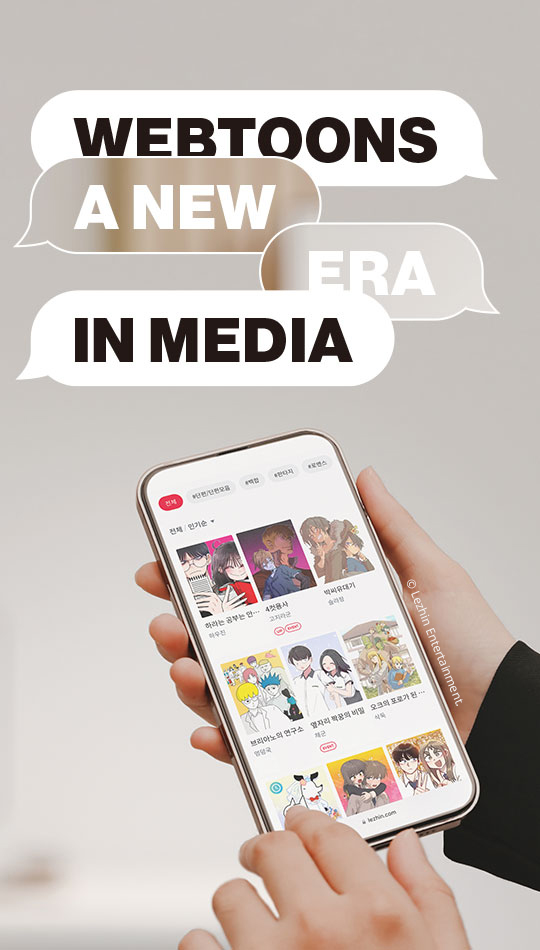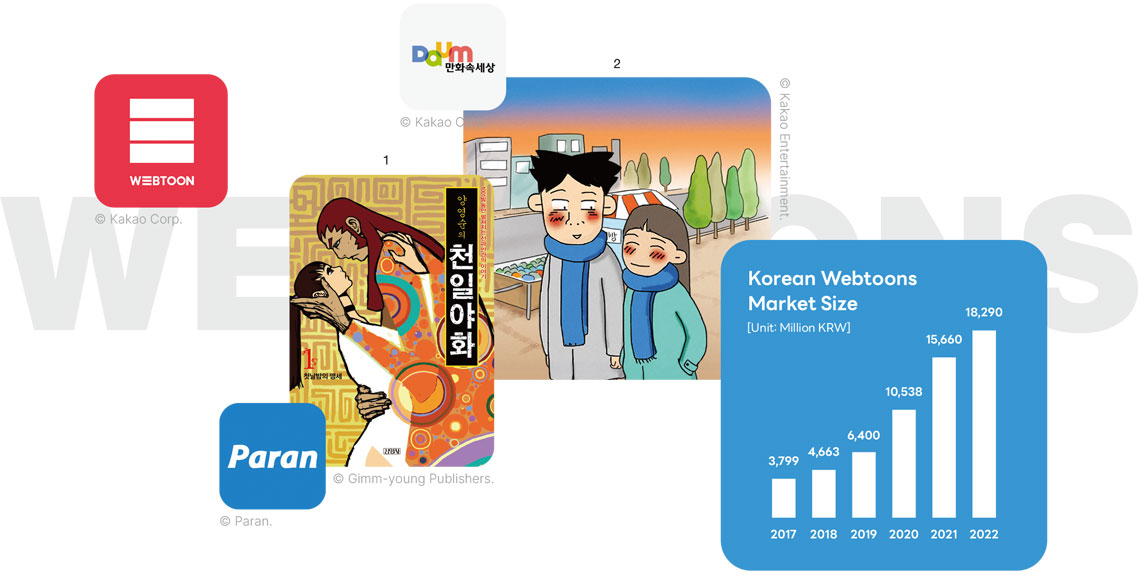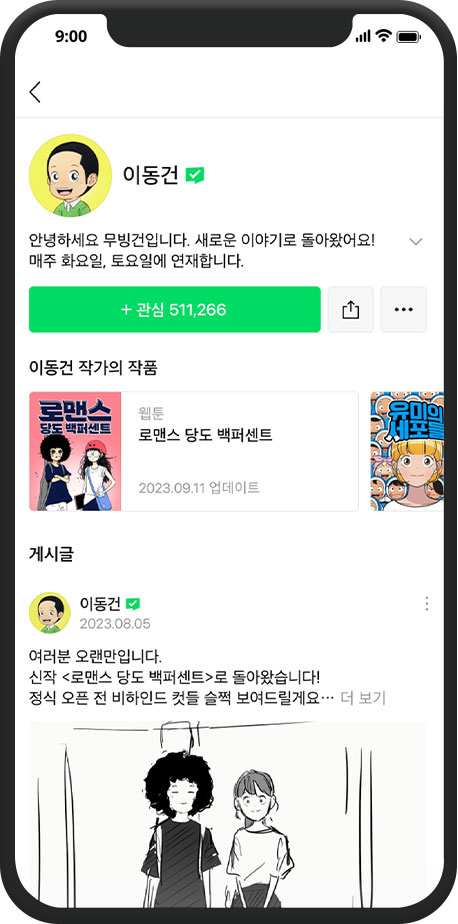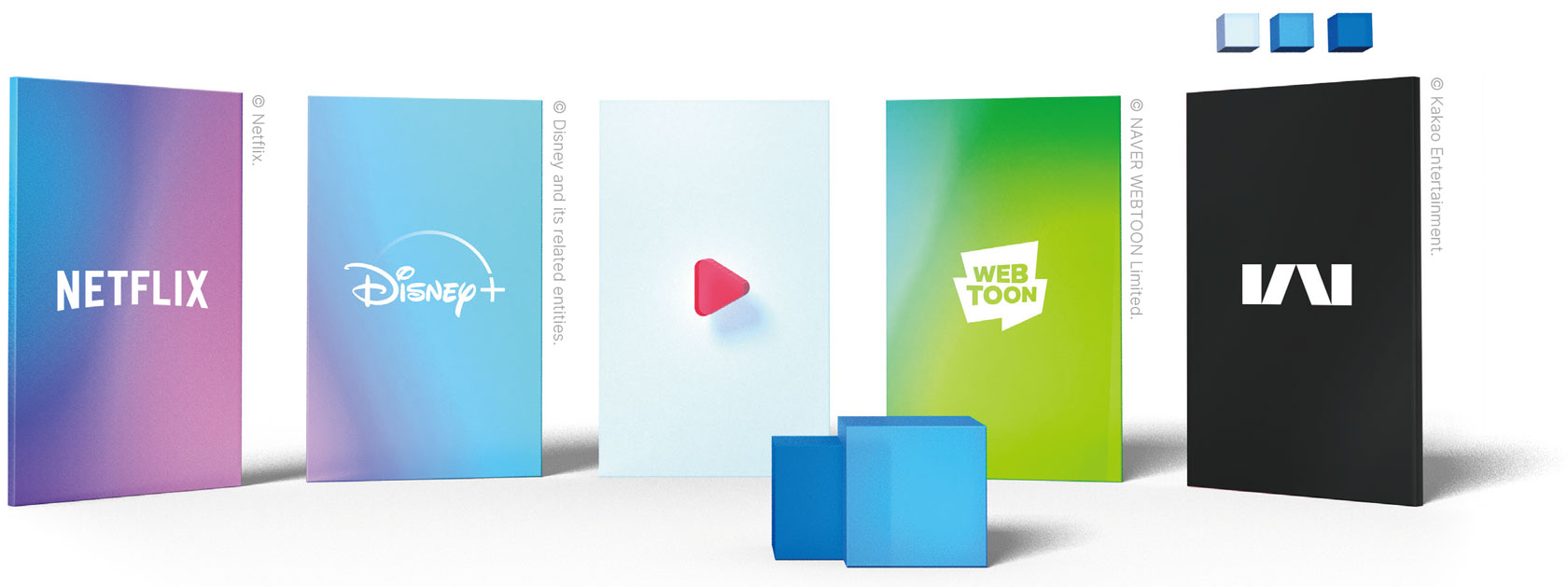A single click transports us into a world of limitless potential; one swipe sends us scrolling through pleasure and pathos. Webtoons are not merely a means of telling a story―they have become an integral part of our very lives. The Korean webtoon industry, born through the development of the internet, has grown exponentially over the past three decades and picked up popularity the world over. Korean webtoons have distinct concepts and their own unique style, telling stories and conveying emotions across national borders as they inaugurate a new era in entertainment.


Writer. Seo Bum Gang
Mobile Era Enables Webtoons’ Birth and Growth
The word “webtoon,” which is a portmanteau of “web” and “cartoon,” was coined to refer to comic strips that were serialized and distributed on the Internet.
Prior to webtoons, there were “digital comics,” which were produced for serialization and distribution in print and then scanned and digitized for online distribution. A later development was “webcomics,” which were produced for online serialization but were identical to print comics in all other respects, including their composition, presentation and reading format. But then, in Apr. 2000, a Korean newspaper used the term “webtoon” to mean comics that were consumed in tandem with videos and background music. As this suggests, “webtoon” is a catchall term to refer to various comics that came into being as the medium of serialization shifted from print to online. But with the passage of time, webtoons have moved beyond the scope of comics and taken on their own distinct significance.
In the 2000s, Korea’s web portals adopted a strategy of providing free access to online comics in order to attract interest and boost traffic. Then in 2003, visual artist Kang Full’s “Sunjeong Manhwa (Romantic Comic)” on Daum’s “World in Comics” service became the first to adopt vertical scrolling, ushering in the genre of full-fledged long-form webtoons that were not merely digital comics or web comics. Subsequently, the vertical scrolling method of panel arrangement was formalized by comic artist Yang Young-soon in his series “1001” on Paran.com, and the current framework of webtoon production was developed by Kang Do-ha in his series “The Great Catsby” on Empas.
 1. Yang Young-soon’s series ‘1001’ / 2. Kang Full’s series ‘Sunjeong Manhwa(Romantic Comic)’
1. Yang Young-soon’s series ‘1001’ / 2. Kang Full’s series ‘Sunjeong Manhwa(Romantic Comic)’
In this way, the presence of webtoons on portal sites resulted in them acquiring three distinctive features.
1. Produced to be read on the screens of digital devices in an online environment.
2. Took the form of immaterial and intangible data.
3. Designed for dynamic transitions through vertical scrolling.
The webtoon industry model ripened with the emergence of small and medium-sized webtoon platforms. For example, Lezhin Entertainment adopted the bold policy of charging for its webtoons, unlike the major portal sites, creating the new business model of a dedicated webtoon platform. Lezhin Entertainment managed to acquire more than 10 million members with sales reaching KRW 40 billion. It ranked first in comic sales on Google Play and first in the book category on the App Store, which was a major factor behind 40 or so dedicated webtoon platforms being in operation by 2018. That helped establish webtoons as paid content and opened the curtain on the golden age of the webtoon industry.

The World in the Palm of Your Hand
So, what are the reasons behind webtoons’ phenomenal growth? First is that webtoons were tailored to the changing patterns of mass consumption. In the past, media consumption required specific places, specific times and specific tools. But the ubiquity of mobile devices means that media can now be consumed anytime and anywhere. As the conditions once necessary for media consumption disappeared, entertainment media began to be reorganized around casual bite-size content without a definite purpose. Taking heed of these changes in consumption patterns, webtoon publishers provided corresponding media delivery methods, usage environments and viewing interfaces. Publishers adopted an innovative media delivery method in which webtoons were available for free to those willing to wait. That gave readers the option to access a wide range of older webtoons without incurring a financial burden. Publishers also adopted user interfaces and curation methods that customized the service for individual users through an analysis of their usage patterns and media preferences. They also created a new format that optimized time and maximized dynamic presentation through vertical scrolling, which can be easily done with one hand. This vertical scrolling technique gave webtoons a novel advantage: they could be comfortably read without moving around or zooming in on the screen even on a small mobile device.
Second, webtoons are easier, faster and more convenient to read than any other type of mobile media, being available whenever you want and wherever you are. While mobile devices can serve a variety of purposes, they are generally used (aside from their primary purposes of phone calls and work) while on public transit or to occupy spare moments between other activities. At such times, webtoons are always easy to load up regardless of time and location, unlike games, videos or music. Viewers can freely adjust the speed of their scrolling with their thumb without detracting from the comics’ emotional impact, and because there is no auditory component, they need not worry about bothering other people even if they forgot their earphones. In the end, webtoons are best suited for the brief timeframes and restricted spaces that are most commonly available to modern people, facilitating quick, easy and convenient consumption anytime and anywhere.
Third, active communities have formed around Korea’s webtoon platforms. Whereas comics in the past represented a one-way flow of information, webtoons support comments by which readers can communicate with the author in real-time and also share their opinions about the webtoon with each other. This provides an experience comparable to watching a movie with somebody else and sharing one’s feelings about it, which is often much more enjoyable than watching a movie alone. Augmenting webtoons with communication and information-sharing functionality helps increase reader participation and raise and maintain interest in artists and their work.
The innovative and unique features of Korean webtoons have ultimately proven effective in the global market, becoming a key driver behind the growth of the webtoon industry as a whole.
 Naver has created a space called ‘Author Home’ where authors and readers can communicate directly. © NAVER WEBTOON Limited.
Naver has created a space called ‘Author Home’ where authors and readers can communicate directly. © NAVER WEBTOON Limited.
Unlimited Potential for Growth
The webtoon industry has proven itself enormously capable despite its relative youth. Webtoons are breaking records in countries around the world, and global consumers have responded to webtoons’ exciting and emotional appeal by becoming avid fans. In addition, worldwide streaming services such as Netflix and Disney+ have produced hit TV shows based on webtoons, earning even more plaudits for the genre. Even Apple and Amazon have gotten into the webtoon business. Kazuhiko Torishima, editor of comic book “Weekly Shonen Jump” in Japan, former leader of the global comic market, once remarked that webtoons are the first serious rival for Japanese manga (comics). In other words, webtoons are not being compared to comics so much as they are writing a new history of their own.
What the Korean webtoon industry needs to focus on now is recruiting professionals to translate webtoons and to train translators who specialize in webtoons. The quality of the work and the effectiveness of its delivery depend on the translation. As this indicates, Korean webtoons need to serve as an important vehicle for cultural exchange to optimize the reading experience for people around the world.
Furthermore, the Korean government is gearing up to support the era of the global webtoon industry. The Ministry of Culture, Sports and Tourism has promised to host a global webtoon festival and awards in Korea to give the genre greater global reach. That means we can look forward to an event at which comic artists and readers from around the world can mingle together and recognize and reward the best works in the genre.


Seo Bum Gang
CEO of INAMUTOON, Chairman of the Korea Webtoon Industry Association
Seo Bum Gang runs INAMUTOON, a webtoon platform he launched for children and families. Since becoming chairman of the Korea Webtoon Industry Association in 2020, he has been working to undergird the webtoon ecosystem with a virtuous cycle of capable of sustained growth. He has won a Best Character and Clean Content Award in 2018, a Cultural Figure Practicing Historical Justice Award in 2021, a Korean Comics and Culture Award in 2022, a commendation from the Minister of Culture, Sports and Tourism in 2022 and a Korea Content Awards in 2023.
